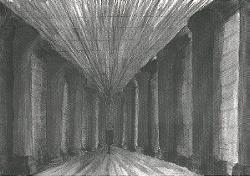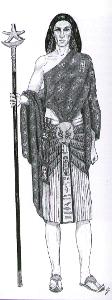![]()
![]()
GODS OF EDEN
PAGE 2
Where did this profound knowledge of ancient technologies come from? Andrew proposes it was from the descendants of Egypt's Sphinx-building Elder culture which he believes dispersed into the Near East sometime around 9500 BC. Hall of Records. The author re-confirms the existence of a high culture in Egypt between 12,500 and 9500 BC that constructed the Sphinx along with other great stone temples at Giza and Abydos.
|
Temple of Horus at Edfu |
These
primeval god-men are quite specifically referred to in a body of
literature known as the Edfu Building Texts found carved on the
walls of the Ptolemaic temple of Edfu in Upper Egypt. Andrew shows
how when the Elder gods (they are named variously in the texts as
the Elders, the Shebtiu, the Falcons, the Sages and the Ancestors)
disappear from the Nile valley, the first neolithic communities
begin to spring up in the Upper Euphrates valley of northern Syria,
south-east Turkey (Anatolia).
He shows that as early as 7500 BC temples of immense beauty and sophistication, one astronomically aligned to the stars of Cetus, were being constructed in this same region, complete with standing stones and paved floors. The art and sculptures found in a temple structure at Nevali Cori, near Urfa in south-east Turkey, clearly indicate that those who ruled here were shamans he identifies as the above-mentioned priestly elite who took on the mantle of the vulture as the ultimate symbol of death and transformation in neolithic times. Andrew also presents firm evidence for the existence of Edgar Cayce's so-called Hall of Records. |
We know that there is firm evidence for the existence of undiscovered chambers beneath the Sphinx enclosure. Ground scans have revealed up to nine hollow areas of regular shape, suggesting human manufacture. Myths and legends going back to Roman times speak of hidden chambers beneath the Giza plateau. The oldest known account, by the Latin writer Ammanias Marcellinus of the fourth century AD, says they were originally constructed for the purposes of strange magical rites before the time of the deluge. Other Coptic Christian stories recorded by Arab historians say they were the repositories for the ancient sciences and treasures of a great civilisation that existed before the time of the Great Flood, which the Coptic Abou Hormeis MS suggests occurred around 9220 BC. In the 1930s American psychic Edgar Cayce referred to these chambers as the Hall of Records, and the name has stuck. What exactly were these chambers, who built them and for what reason might they have been constructed?
By deciphering the Edfu Building Texts Andrew came to realise that the homeland of the Eldest Ones, the first netjeru-gods, was almost certainly a physical location. That location appears to have been Giza, which was then known as Rostau. The texts describe it not as it appeared during the pyramid age, but much earlier when the Elders inhabited the world. They speak of Giza as possessing a sacred lake that contained a small, central island, seen as the mound of First Creation. On this was a structure known as the Place of the Well, seemingly some kind of stairwell, leading down to an antechamber. From this stretched a long horizontal tunnel, known as the road of Rostau, which would take the initiate to a huge subterranean complex referred to in the texts as the Underworld of the Soul. In other texts it simply became the am-duat, the underworld domain, through which the sun passed each night and the deceased pharaoh must navigate on his final journey to the afterlife among the stars of Orion.The texts suggest that Giza's underworld domain was a microcosmic model of the passage of time and the processes of First Creation in the physical universe. It consisted of twelve chambers placed in a circle around a thirteenth one that contained an enormous erect stone known variously as the seed, egg or phallus-benben. It embodied the male and female creative powers, very much like the lingam stones of Hindu tradition.
| The texts say that the mythical characters known as Shebtiu would enter inside the complex and conduct strange rites using held-held power objects (iht), plausibly large crystals or small lingam stones, in order to perpetuate the act of creation in the outside world. The only way these ideas can be assimilated is to liken them to the harmonic convergence events carried out each year since 1987 at key sacred sites around the globe. |
Artist's impression of the Hall of Records |
Their purpose is to supposedly affect human consciousness through collective meditation and chanting; something similar to what Andrew's Meonia group has been striving to achieve in Britain since 1992.
Using the information contained in the ancient texts as well as the latest archaeological evidence from Giza itself, Andrew has pinpointed the position of Giza's sacred island of creation, within which was the entrance to the Underworld of the Soul. It lay at a spot some several hundred metres due east of the Sphinx and Valley Temple. Unfortunately, if this is the case, then it is inaccessible today due to modern-day development. His findings concur with those of Edgar Cayce's psychic prophecy, which predicted that the entrance to the Hall of Records lay between the Sphinx and the Nile river. Yet he also claimed that a connecting tunnel led from this entrance to a position beneath the right paw of the Sphinx, so let's hope he was right on this one as well.
|
Chief of the Astronomers, Heliopolis |
The Edfu Building Texts also speak of the Shebtiu sailing away to another part of the mythical world at the end of the initial period of creation.Andrew builds up a case to show that it was into the Near East that they sailed, via the Levant coast. It was beyond here, in the hills and mountains of Kurdistan, that the Watcher culture sprang into existence almost certainly as a result of the demise of Egypt's Elder culture. Not only did they initiate the neolithic age by controlling the progress of individual communities, but it was their influence which eventually spilled over on to the plains of Mesopotamia in around 5000 BC. Gradually the civilisation of Sumer arose, and eventually they themselves set their sights on Egypt, returning between c. 4000-3000 BC as the so-called eastern invaders, or Followers of Horus, who overthrew the age-old indigenous 'Set' tribes of the Nile valley. The last descendants of the Sphinx-building Elder gods thus returned to their homeland 5500 years after their original departure in c. 9500-9000 BC. It was these people who inspired the construction of the Great Pyramid and very possibly introduced the high technology clearly present during the pyramid age. |
![]()
![]()


